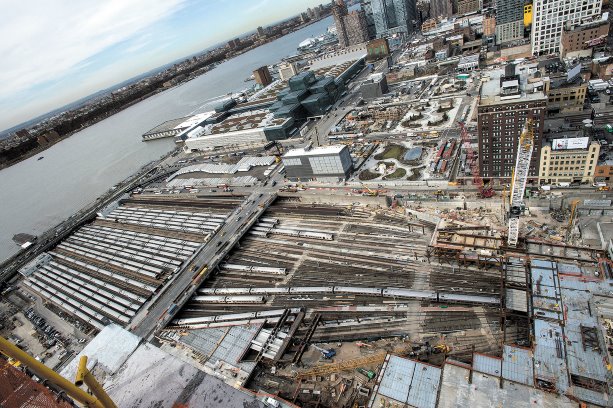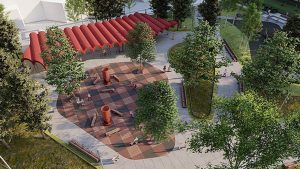When a rail yard occupies 28 acres of some of the most valuable real estate in the world, New York City opted to build over top of it. Hudson Yards, a massive multi-use development, is counting on two steel platforms totaling 21-acres with an estimated construction cost of US$1.5 billion to make the project a reality.
Billed as the largest private real estate development in U.S. history, the Manhattan project is being developed jointly by Related Companies and Canada’s Oxford Properties Group. Among the site’s planned offerings: 17 million sq. ft. of commercial and residential space, a 200-room hotel, more than 100 shops, restaurants, about 5,000 residences, a public school and 14 acres of public space.
Tutor Perini is the project’s general contractor and Thornton Tomasetti is the platform’s structural engineer.
Related and Oxford ordered 100,000 tons of steel to complete the Eastern Rail Yard Platform and to begin construction on the 92-storey, 30 Hudson Yards office tower and retail centre.
Multiple fabricators and installers were contracted to work on the project.
Construction began on the Eastern Rail Yard Platform in March 2014.
The Hudson Yards rail infrastructure includes 30 active Long Island Rail Road tracks and three subsurface Amtrak and New Jersey Transit rail tunnels.
The most challenging aspect of designing the project was locating the 300 caissons between tracks to support the steel structure.
"Their installation was sequenced so that the Long Island Rail Road trains could keep running during construction" said Emad Lotfalla, director of construction for Hudson Yards.
"Due to the location of the tracks and underground tunnels and utilities, only 38 per cent of the Eastern Rail Yards could be used to support structures. The team went through an extensive effort to identify the ideal layout and flexibility for structure development."
The first crane on site used for platform construction was a 220-foot Manitowoc 18000 with lifting capacity of 660 tons.
It was replaced in March by a Favco 1280 tower crane, with a lifting capacity of 100 tons and a reach of more than 120 ft.
Some of the larger steel elements include 12-foot-deep trusses and 8-foot-deep plate girder I-beams.
Solid steel columns measure 42"x42" and are made up of stacked plates welded together. The larger concrete planks supported by the steel structure measure 30 ft. by four ft., and weigh almost 12,000 lbs. each.
"For the areas spanning the tracks, the main typology is a system of 12-ft.-deep, long-span double trusses supporting precast plank on the bottom chord to cover the tracks and steel framing on the upper chord to provide flexibility for the fit out above," said Lotfalla.
"The double trusses are being utilized to meet the crane pick limits for these 150-ft. spans and to support what will eventually be the retail structure above. For the areas not over the tracks, steel framing with cast-in-place slabs on metal deck are typically being utilized."
For the area that will become the retail centre loading dock, located within the platform and partly over the tracks, the construction crew is using a two-way steel grid and cast-in-place concrete slab. The system was assembled in panels 10 ft. wide by 70 ft. long with a preset slab form so that panels could be set quickly over tracks during short-term closures.
Construction is currently underway at the railway "throat," where 30 tracks converge into four main tracks approaching Penn Station and no caissons can be located.
"Massive steel trusses bridge 90 ft. across this zone and provide the base for 30 Hudson Yards and the seven-level, one million-sq. ft. retail centre," said Lotfalla. "Here, we’re almost 50 per cent complete."
30 Hudson Yards will still be partially supported by caissons. Only the 52-storey 10 Hudson Yards will be constructed entirely on caissons.
Working around train schedules has been critical.
"Where there are 30 tracks, the Long Island Rail Road has allowed Related and Oxford to take four tracks out of service at a time," said Lotfalla.
"Where the tracks converge down to four, however, only one track can be taken out of service at a time and only for a couple of hours."
The Eastern Rail Yards platform project is scheduled for completion later this year with the entire Eastern project scheduled for completion in 2018. The full Hudson Yards project is aiming for a 2024 completion date












Recent Comments
comments for this post are closed